
List of mammals of Bangladesh
Encyclopedia

Bangladesh
Bangladesh , officially the People's Republic of Bangladesh is a sovereign state located in South Asia. It is bordered by India on all sides except for a small border with Burma to the far southeast and by the Bay of Bengal to the south...
, of which 3 are critically endangered, 12 are endangered, 16 are vulnerable, and 4 are near-threatened.
The following tags are used to highlight each species' conservation status as assessed by the IUCN
World Conservation Union
The International Union for Conservation of Nature and Natural Resources is an international organization dedicated to finding "pragmatic solutions to our most pressing environment and development challenges." The organization publishes the IUCN Red List, compiling information from a network of...
:
| EX | Extinct | No reasonable doubt that the last individual has died. |
| EW | Extinct in the wild | Known only to survive in captivity or as a naturalized populations well outside its previous range. |
| CR | Critically Endangered | The species is in imminent risk of extinction in the wild. |
| EN | Endangered | The species is facing an extremely high risk of extinction in the wild. |
| VU | Vulnerable | The species is facing a high risk of extinction in the wild. |
| NT | Near Threatened | The species does not meet any of the criteria that would categorise it as risking extinction but it is likely to do so in the future. |
| LC | Least Concern | There are no current identifiable risks to the species. |
| DD | Data Deficient | There is inadequate information to make an assessment of the risks to this species. |
Some species were assessed using an earlier set of criteria. Species assessed using this system have the following instead of Near Threatened and Least Concern categories:
| LR/cd | Lower Risk/conservation dependent | Species which were the focus of conservation programmes and may have moved into a higher risk category if that programme was discontinued. |
| LR/nt | Lower Risk/near threatened | Species which are close to being classified as Vulnerable but are not the subject of conservation programmes. |
| LR/lc | Lower Risk/least concern | Species for which there are no identifiable risks. |
Order: ProboscideaProboscideaProboscidea is a taxonomic order containing one living family, Elephantidae, and several extinct families. This order was first described by J. Illiger in 1881 and encompasses the trunked mammals...
(elephants)
----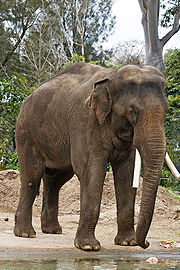
-
- Family: ElephantidaeElephantidaeElephantidae is a taxonomic family, collectively elephants and mammoths. These are terrestrial large mammals with a trunk and tusks. Most genera and species in the family are extinct...
(elephants)- Genus: ElephasElephasElephas is one of two surviving genera in the order of elephants, Proboscidea. The genus has one surviving species, the Asian elephant Elephas maximus....
- Asian ElephantAsian ElephantThe Asian or Asiatic elephant is the only living species of the genus Elephas and distributed in Southeast Asia from India in the west to Borneo in the east. Three subspecies are recognized — Elephas maximus maximus from Sri Lanka, the Indian elephant or E. m. indicus from mainland Asia, and E. m....
Elephas maximus EN
- Asian Elephant
- Genus: Elephas
- Family: Elephantidae
Order: SireniaSireniaSirenia is an order of fully aquatic, herbivorous mammals that inhabit swamps, rivers, estuaries, marine wetlands, and coastal marine waters. Four species are living, in two families and genera. These are the dugong and manatees...
(manatees and dugongs)
Sirenia is an order of fully aquatic, herbivorous mammals that inhabit rivers, estuaries, coastal marine waters, swamps, and marine wetlands. All four species are endangered.
-
- Family: DugongidaeDugongidaeDugongidae is a family in the order of Sirenia.The family has one surviving species, the Dugong , one recently extinct species, the Steller's Sea Cow , and a number of extinct genera known from the fossil record....
- Genus: DugongDugongThe dugong is a large marine mammal which, together with the manatees, is one of four living species of the order Sirenia. It is the only living representative of the once-diverse family Dugongidae; its closest modern relative, Steller's sea cow , was hunted to extinction in the 18th century...
- DugongDugongThe dugong is a large marine mammal which, together with the manatees, is one of four living species of the order Sirenia. It is the only living representative of the once-diverse family Dugongidae; its closest modern relative, Steller's sea cow , was hunted to extinction in the 18th century...
Dugong dugon VU
- Dugong
- Genus: Dugong
- Family: Dugongidae
Order: Primates
----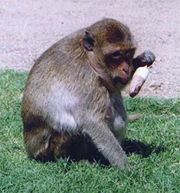

Lemur
Lemurs are a clade of strepsirrhine primates endemic to the island of Madagascar. They are named after the lemures of Roman mythology due to the ghostly vocalizations, reflective eyes, and the nocturnal habits of some species...
s, monkey
Monkey
A monkey is a primate, either an Old World monkey or a New World monkey. There are about 260 known living species of monkey. Many are arboreal, although there are species that live primarily on the ground, such as baboons. Monkeys are generally considered to be intelligent. Unlike apes, monkeys...
s, and ape
Ape
Apes are Old World anthropoid mammals, more specifically a clade of tailless catarrhine primates, belonging to the biological superfamily Hominoidea. The apes are native to Africa and South-east Asia, although in relatively recent times humans have spread all over the world...
s, with the latter category including humans. It is divided informally into three main groupings: prosimian
Prosimian
Prosimians are a grouping of mammals defined as being primates, but not monkeys or apes. They include, among others, lemurs, bushbabies, and tarsiers. They are considered to have characteristics that are more primitive than those of monkeys and apes. Prosimians are the only primates native to...
s, monkeys of the New World
New World monkey
New World monkeys are the five families of primates that are found in Central and South America: Callitrichidae, Cebidae, Aotidae, Pitheciidae, and Atelidae. The five families are ranked together as the Platyrrhini parvorder and the Ceboidea superfamily, which are essentially synonymous since...
, and monkeys and apes of the Old World
Catarrhini
Catarrhini is one of the two subdivisions of the higher primates . It contains the Old World monkeys and the apes, which in turn are further divided into the lesser apes or gibbons and the great apes, consisting of the orangutans, gorillas, chimpanzees, bonobos, and humans...
.
- Suborder: StrepsirrhiniStrepsirrhiniThe clade Strepsirrhini is one of the two suborders of primates. Madagascar's only non-human primates are strepsirrhines, and others can be found in southeast Asia and Africa...
- Infraorder: LorisiformesLorisiformesLorisiformes are a group of primates found throughout Africa and Asia. Members of this infraorder include the galagos and the lorises. As strepsirrhines, they are related to the lemurs.* Order Primates** Suborder Strepsirrhini: non-tarsier prosimians...
- Family: LorisidaeLorisidaeLorisidae is a family of strepsirrhine primates. The lorisids are all slim arboreal animals and include the lorises, pottos and angwantibos. Lorisids live in tropical, central Africa as well as in south and southeast Asia....
(lorises, bushbabies)- Genus: Nycticebus
- Sunda LorisSunda LorisThe Sunda slow loris or greater slow loris is a strepsirrhine primate and a species of slow loris native to Indonesia, western Malaysia, southern Thailand and Singapore. It measures from head to tail and weighs between...
Nycticebus coucang LR/lc
- Sunda Loris
- Genus: Nycticebus
- Family: Lorisidae
- Infraorder: Lorisiformes
- Suborder: HaplorrhiniHaplorrhiniThe haplorhines, the "dry-nosed" primates , are members of the Haplorhini clade: the prosimian tarsiers and the anthropoids...
- Infraorder: Simiiformes
- Parvorder: CatarrhiniCatarrhiniCatarrhini is one of the two subdivisions of the higher primates . It contains the Old World monkeys and the apes, which in turn are further divided into the lesser apes or gibbons and the great apes, consisting of the orangutans, gorillas, chimpanzees, bonobos, and humans...
- Superfamily: Cercopithecoidea
- Family: Cercopithecidae (Old World monkeys)
- Genus: MacacaMacaqueThe macaques constitute a genus of Old World monkeys of the subfamily Cercopithecinae. - Description :Aside from humans , the macaques are the most widespread primate genus, ranging from Japan to Afghanistan and, in the case of the barbary macaque, to North Africa...
- Stump-tailed MacaqueStump-tailed MacaqueThe stump-tailed macaque , also called the bear macaque, is a species of macaque found in Southern Asia. In India, it is found in south of the Brahmaputra river, in northeastern part of the country.Its range in India extends from Assam and Meghalaya to eastern Aruanchal Pradesh, Nagaland, Manipur,...
Macaca arctoides VU - Assam MacaqueAssam MacaqueThe Assam macaque is a macaque of the Old World monkey family native to South and Southeast Asia. Since 2008, the species is listed as Near Threatened by IUCN, as it is experiencing significant declines due to hunting, habitat degradation and fragmentation.- Characteristics :The Assam macaque has...
Macaca assamensis VU - Crab-eating MacaqueCrab-eating MacaqueThe Crab-eating macaque is a cercopithecine primate native to Southeast Asia. It is also called the "long-tailed macaque", and is referred to as the "cynomolgus monkey" in laboratories.-Etymology:...
Macaca fascicularis LR/nt - Northern Pigtail Macaque Macaca leonina VU
- Rhesus MacaqueRhesus MacaqueThe Rhesus macaque , also called the Rhesus monkey, is one of the best-known species of Old World monkeys. It is listed as Least Concern in the IUCN Red List of Threatened Species in view of its wide distribution, presumed large population, and its tolerance of a broad range of habitats...
Macaca mulatta LR/nt
- Stump-tailed Macaque
- Subfamily: ColobinaeColobinaeColobinae is a subfamily of the Old World monkey family that includes 59 species in 10 genera, including the skunk-like black-and-white colobus, the large-nosed proboscis monkey, and the gray langurs. Some classifications split the colobine monkeys into two tribes, while others split them into...
- Genus: Semnopithecus
- Gray langurGray langurGray langurs or Hanuman langurs, the most widespread langurs of South Asia, are a group of Old World monkeys constituting the entirety of the genus Semnopithecus. All taxa have traditionally been placed in the single species Semnopithecus entellus...
Semnopithecus entellus LR/nt
- Gray langur
- Genus: Trachypithecus
- Dusky Leaf MonkeyDusky Leaf Monkeythumb|200px|left|adult male spectacled langurThe dusky leaf monkey, spectacled langur, or spectacled leaf monkey is a species of primate in the Cercopithecidae family...
Trachypithecus obscurus LR/lc - Bonneted Langur Trachypithecus pileatus EN
- Dusky Leaf Monkey
- Genus: Semnopithecus
- Genus: Macaca
- Family: Cercopithecidae (Old World monkeys)
- Superfamily: Hominoidea
- Family: Hylobatidae (gibbons)
- Genus: Bunopithecus
- Hoolock gibbonHoolock gibbonThe hoolock gibbons , also known as hoolocks, are two primate species from the family of the gibbons .Hoolocks are the second largest of the gibbons, after the Siamang. They reach a size of 60 to 90 cm and weigh 6 to 9 kg...
Bunopithecus hoolock EN
- Hoolock gibbon
- Genus: Bunopithecus
- Family: Hylobatidae (gibbons)
- Superfamily: Cercopithecoidea
- Parvorder: Catarrhini
- Infraorder: Simiiformes
Order: RodentRodentRodentia is an order of mammals also known as rodents, characterised by two continuously growing incisors in the upper and lower jaws which must be kept short by gnawing....
ia (rodents)
----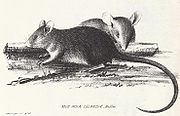

Incisor
Incisors are the first kind of tooth in heterodont mammals. They are located in the premaxilla above and mandible below.-Function:...
s in the upper and lower jaw which grow continually and must be kept short by gnawing. Most rodents are small though the capybara
Capybara
The capybara , also known as capivara in Portuguese, and capibara, chigüire in Venezuela, Colombia, and Ecuador ronsoco in Peru, chigüiro, and carpincho in Spanish, is the largest living rodent in the world. Its closest relatives are agouti, chinchillas, coyphillas, and guinea pigs...
can weigh up to 45 kg (100 lb).
- Suborder: SciurognathiSciurognathiSciurognathi is a suborder of rodents that includes squirrels, chipmunks, beavers, and many types of mice. The group is characterized by a specific shape to the lower jaw. In sciurognaths, the angular process of the jaw is in the same plane as the root of the incisors...
- Family: Sciuridae (squirrels)
- Subfamily: Ratufinae
- Genus: Ratufa
- Black Giant SquirrelBlack Giant SquirrelThe black giant squirrel is a large tree squirrel in the genus Ratufa native to the Indomalayan zootope...
Ratufa bicolor LR/lc
- Black Giant Squirrel
- Genus: Ratufa
- Subfamily: SciurinaeSciurinaeThe Sciurinae is a subfamily of squirrels in the . It unites the flying squirrels with certain related tree squirrels. Older sources place the flying squirrels in a separate subfamily and unite all remaining sciurids into the subfamily Sciurinae, but this has been strongly refuted by genetic...
- Tribe: Pteromyini
- Genus: HylopetesHylopetesHylopetes is a genus of flying squirrels.-Species:*Particolored Flying Squirrel Hylopetes alboniger *Afghan Flying Squirrel Hylopetes baberi *Bartel's Flying Squirrel Hylopetes bartelsi Chasen, 1939...
- Particolored Flying SquirrelParticolored Flying SquirrelThe Particolored Flying Squirrel is a species of rodent in the Sciuridae family. It is found in Bangladesh, Bhutan, Cambodia, China, India, Laos, Myanmar, Nepal, Thailand, and Vietnam. Its natural habitat is subtropical or tropical dry forests. It is threatened by habitat loss....
Hylopetes alboniger EN
- Particolored Flying Squirrel
- Genus: PetauristaPetauristaPetaurista is a genus of rodent in the Sciuridae family. Squirrels in this family are generally large nocturnal squirrels.It contains the following species:* Red And White Giant Flying Squirrel...
- Bhutan Giant Flying SquirrelBhutan Giant Flying SquirrelThe Bhutan Giant Flying Squirrel is a species of rodent in the Sciuridae family. It is found in Bangladesh, Bhutan, China, India, and Nepal. Its natural habitat is temperate forests. It is threatened by habitat loss....
Petaurista nobilis LR/nt
- Bhutan Giant Flying Squirrel
- Genus: Hylopetes
- Tribe: Pteromyini
- Subfamily: CallosciurinaeCallosciurinaeCallosciurinae is an Asiatic subfamily of squirrels. It contains about 60 species, most of them in South East Asia. It is named after the Callosciurus genus, which means 'Beautiful Squirrels'.-Classification:*Family Sciuridae...
- Genus: CallosciurusCallosciurusCallosciurus is a genus of squirrels collectively referred to as the "Beautiful squirrels". They are found mainly in Southeast Asia, though a few species also occur in Nepal, northeastern India, Bangladesh and southern China. Several of the species have settled on islands. In total, the genus...
- Irrawaddy Squirrel Callosciurus pygerythrus VU
- Genus: Callosciurus
- Subfamily: Ratufinae
- Family: SpalacidaeSpalacidaeThe Spalacidae, or spalacids are a family of rodents in the large and complex superfamily Muroidea. They are native to eastern Asia, the Horn of Africa, the Middle East, and south-eastern Europe. It includes the blind mole rats, bamboo rats, root rats, and zokors...
- Subfamily: RhizomyinaeRhizomyinaeThe subfamily Rhizomyinae of rodents includes the Asian bamboo rats and certain of the African mole rats. The subfamily is grouped with the Spalacinae and the Myospalacinae into a family of fossorial muroid rodents basal to the other Muroidea....
- Genus: Cannomys
- Lesser Bamboo RatLesser Bamboo RatThe Lesser Bamboo Rat is a species of rodent in the Spalacidae family. It is monotypic within the genus Cannomys.It is found in Bangladesh, Bhutan, Cambodia, China, India, Myanmar, Nepal, and Thailand.-References:...
Cannomys badius LR/lc
- Lesser Bamboo Rat
- Genus: Cannomys
- Subfamily: Rhizomyinae
- Family: MuridaeMuridaeMuridae is the largest family of mammals. It contains over 600 species found naturally throughout Eurasia, Africa, and Australia. They have been introduced worldwide. The group includes true mice and rats, gerbils, and relatives....
(mice, rats, voles, gerbils, hamsters, etc.)- Subfamily: MurinaeMurinaeThe Old World rats and mice, part of the subfamily Murinae in the family Muridae, comprise at least 519 species. This subfamily is larger than all mammal families except the Cricetidae and Muridae, and is larger than all mammal orders except the bats and the remainder of the...
- Genus: BandicotaBandicotaBandicota is a genus of rodent from Asia. They are known as the bandicoot rats.-Species:Genus Bandicota - bandicoot rats*Lesser Bandicoot Rat, Bandicota bengalensis Gray and Hardwicke, 1833...
- Lesser Bandicoot RatLesser Bandicoot RatThe Lesser Bandicoot Rat is a giant rat of Southern Asia, not related to the true bandicoots. They can be up to 40 cm long . It is considered a pest in the cereal crops and gardens of India and Sri Lanka, and emits piglike grunts when attacking...
Bandicota bengalensis LR/lc
- Lesser Bandicoot Rat
- Genus: LeopoldamysLeopoldamysLeopoldamys is a genus of rodent in the family Muridae.It contains the following species:* Sundaic Mountain Long-tailed Giant Rat * Edwards's Long-tailed Giant Rat...
- Long-tailed Giant RatLong-tailed Giant RatThe Long-tailed Giant Rat is a species of rodent in the family Muridae.It is found in Bangladesh, Cambodia, Indonesia, Laos, Malaysia, Thailand, and Vietnam.-References:* Baillie, J. 1996. . Downloaded on 9 July 2007....
Leopoldamys sabanus LR/lc
- Long-tailed Giant Rat
- Genus: MillardiaMillardiaMillardia is a genus of rodent in the family Muridae.It contains the following species:* Sand-colored Soft-furred Rat * Miss Ryley's Soft-furred Rat * Kondana Soft-furred Rat...
- Soft-furred RatSoft-furred RatThe Soft-furred Rat is a species of rodent in the family Muridae.It is found in Bangladesh, India, Nepal, and Sri Lanka.-References:* Baillie, J. 1996. . Downloaded on 9 July 2007....
Millardia meltada LR/lc
- Soft-furred Rat
- Genus: NesokiaNesokiaNesokia is a genus of rodent in the family Muridae.It contains the following species:* Bunn's Short-tailed Bandicoot Rat * Short-tailed Bandicoot Rat -References:...
- Short-tailed Bandicoot RatShort-tailed Bandicoot RatThe Short-tailed Bandicoot Rat is a species of rodent in the family Muridae.Other common names include Short-tailed Mole Rat, Indian Bandicoot, Bandicoot-rat, Flat-tooth Rat and Short-tailed Nesokia....
Nesokia indica LC
- Short-tailed Bandicoot Rat
- Genus: NiviventerNiviventerNiviventer is a genus of rodent in the family Muridae. It contains the following species:* Anderson's White-bellied Rat, Niviventer andersoni* Brahma White-bellied Rat, Niviventer brahma...
- Chestnut White-bellied RatChestnut White-bellied RatThe Chestnut White-bellied Rat is a species of rodent in the family Muridae.It is found in Bangladesh, Cambodia, China, India, Indonesia, Laos, Malaysia, Nepal, Pakistan, Thailand, and Vietnam.-References:...
Niviventer fulvescens LR/lc
- Chestnut White-bellied Rat
- Genus: Rattus
- Polynesian RatPolynesian RatThe Polynesian Rat, or Pacific Rat , known to the Māori as kiore, is the third most widespread species of rat in the world behind the Brown Rat and Black Rat. The Polynesian Rat originates in Southeast Asia but, like its cousins, has become well travelled – infiltrating Fiji and most Polynesian...
Rattus exulans LR/lc - Himalayan Field RatHimalayan Field RatThe Himalayan Field Rat is a species of rodent in the family Muridae.It is found in Bangladesh, China, India, Indonesia, Laos, Myanmar, Nepal, Sumatra, Palau, the Philippines, Thailand, and Vietnam.-References:...
Rattus nitidus LR/lc - Tanezumi RatTanezumi RatThe Tanezumi Rat is a species of rodent in the family Muridae.It is found in Bangladesh, Cambodia, China, Cocos Islands, Fiji, India, Indonesia, Japan, North Korea, South Korea, Laos, Malaysia, Myanmar, Nepal, the Philippines, Taiwan, Thailand, and Vietnam.-References:* Baillie, J. 1996. . ...
Rattus tanezumi LR/lc
- Polynesian Rat
- Genus: VandeleuriaVandeleuriaVandeleuria is a small genus of rodent from Asia with only three species. Also known as the long-tailed climbing mice.-Species:Genus Vandeleuria - long-tailed climbing mice...
- Asiatic Long-tailed Climbing Mouse Vandeleuria oleracea LR/lc
- Genus: Bandicota
- Subfamily: Murinae
- Family: Sciuridae (squirrels)
Order: LagomorphaLagomorphaThe lagomorphs are the members of the taxonomic order Lagomorpha, of which there are two living families, the Leporidae , and the Ochotonidae...
(lagomorphs)
----The lagomorphs comprise two families, Leporidae
Leporidae
Leporids are the approximately 50 species of rabbits and hares which form the family Leporidae. The leporids, together with the pikas, constitute the mammalian order Lagomorpha. Leporids differ from pikas in having short furry tails, and elongated ears and hind legs...
(hare
Hare
Hares and jackrabbits are leporids belonging to the genus Lepus. Hares less than one year old are called leverets. Four species commonly known as types of hare are classified outside of Lepus: the hispid hare , and three species known as red rock hares .Hares are very fast-moving...
s and rabbit
Rabbit
Rabbits are small mammals in the family Leporidae of the order Lagomorpha, found in several parts of the world...
s), and Ochotonidae (pika
Pika
The pika is a small mammal, with short limbs, rounded ears, and short tail. The name pika is used for any member of the Ochotonidae, a family within the order of lagomorphs, which also includes the Leporidae . One genus, Ochotona, is recognised within the family, and it includes 30 species...
s). Though they can resemble rodent
Rodent
Rodentia is an order of mammals also known as rodents, characterised by two continuously growing incisors in the upper and lower jaws which must be kept short by gnawing....
s, and were classified as a superfamily
Taxonomic rank
In biological classification, rank is the level in a taxonomic hierarchy. Examples of taxonomic ranks are species, genus, family, and class. Each rank subsumes under it a number of less general categories...
in that order until the early 20th century, they have since been considered a separate order. They differ from rodents in a number of physical characteristics, such as having four incisors in the upper jaw rather than two.
- Family: LeporidaeLeporidaeLeporids are the approximately 50 species of rabbits and hares which form the family Leporidae. The leporids, together with the pikas, constitute the mammalian order Lagomorpha. Leporids differ from pikas in having short furry tails, and elongated ears and hind legs...
(rabbits, hares)- Genus: Caprolagus
- Hispid HareHispid HareThe Hispid hare Caprolagus hispidus, also called Assam rabbit is a leporid native to South Asia, whose historic range extended along the southern foothills of the Himalayas. Today, the habitat of hispid hares is highly fragmented with an area of occupancy of less than extending over an estimated...
Caprolagus hispidus EN
- Hispid Hare
- Genus: LepusHareHares and jackrabbits are leporids belonging to the genus Lepus. Hares less than one year old are called leverets. Four species commonly known as types of hare are classified outside of Lepus: the hispid hare , and three species known as red rock hares .Hares are very fast-moving...
- Indian HareIndian HareThe Indian Hare , also known as the Black-naped Hare, is a common species of hare found in South Asia. and in java....
Lepus nigricollis LR/lc
- Indian Hare
- Genus: Caprolagus
Order: SoricomorphaSoricomorphaThe order Soricomorpha is taxon within the class of mammals. In previous years it formed a significant group within the former order Insectivora...
(shrews, moles, and soledons)
----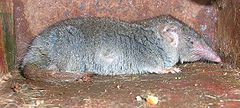
- Family: Soricidae (shrews)
- Subfamily: Crocidurinae
- Genus: CrociduraCrociduraThe genus Crocidura is one of nine genus of the shrew subfamily Crocidurinae. Members of the genus are commonly called white-toothed shrews or musk shrews, although both also apply to all of the species in the subfamily. With 182 species, Crocidura contains the largest number of species of any...
- Southeast Asian ShrewSoutheast Asian ShrewThe Southeast Asian Shrew is a species of mammal in the Soricidae family. It is found in Cambodia, China, Laos, Malaysia, Myanmar, Thailand, and Vietnam.-References:...
Crocidura fuliginosa LR/lc
- Southeast Asian Shrew
- Genus: SuncusSuncusSuncus is a genus of shrews in the family Soricidae.-Classification:*Genus Suncus**Taita Shrew **Black Shrew **Day's Shrew **Etruscan Shrew...
- Asian House Shrew Suncus murinus LR/lc
- Anderson's ShrewAnderson's ShrewThe Anderson's Shrew is a medium-sized species of shrew. It is light gray in color with yellow fur around the throat and pectoral region, comparatively large ears and a tail measures about 50 - 70% of body length....
Suncus stoliczkanus LR/lc
- Genus: Crocidura
- Subfamily: Crocidurinae
Order: Chiroptera (bats)
----The bats' most distinguishing feature is that their forelimbs are developed as wings, making them the only mammals in the world naturally capable of flight. Bat species account for about 20% of all mammals.
- Family: Pteropodidae (flying foxes, Old World fruit bats)
- Subfamily: PteropodinaePteropodinaePteropodinae is a subfamily of megabats. Species within this subfamily are:Subfamily Pteropodinae* Genus Acerodon**Sulawesi Flying Fox, Acerodon celebensis**Talaud Flying Fox, Acerodon humilis...
- Genus: CynopterusCynopterusCynopterus is a genus of megabats. The Cynopterine section is represented by 11 genera, five of which occur in Malaysia, namely, Chironx, Balionycteris, Penthetor, Dyacopterus and Cynopterus...
- Greater Short-nosed Fruit BatGreater Short-nosed Fruit BatThe Greater Short-nosed Fruit Bat or Short-nosed Indian Fruit Bat is a species of megabat in the Pteropodidae family. It is found in South and Southeast Asia.-Description:...
Cynopterus sphinx LR/lc
- Greater Short-nosed Fruit Bat
- Genus: PteropusPteropusBats of the genus Pteropus, belonging to the megabat or Megachiroptera sub-order, are the largest bats in the world. They are commonly known as the fruit bats or flying foxes among other colloquial names...
- Indian Flying-foxIndian Flying-foxThe Indian Flying-fox is a species of megabat in the Pteropodidae family. It is found in Bangladesh, China, India, Maldives, Nepal, Pakistan, and Sri Lanka. Also known as the Greater Indian Fruit Bat, it lives in mainly forests. It is a very large bat with a wing span of between 1.2 and 1.5 meters...
Pteropus giganteus LR/lc
- Indian Flying-fox
- Genus: Cynopterus
- Subfamily: Pteropodinae
- Family: Vespertilionidae
- Subfamily: Myotinae
- Genus: Myotis
- Whiskered MyotisWhiskered MyotisWall-roosting Mouse-eared Bat, or Nepalese Whiskered Myotis is a species of vesper bat in the Vespertilionidae family...
Myotis muricola LR/lc - Himalayan Whiskered BatHimalayan Whiskered BatThe Himalayan Whiskered Bat is a species of vesper bat in the Vespertilionidae family.It is found in Bangladesh, Bhutan, Cambodia, China, India, Indonesia, Laos, Malaysia, Nepal, and Vietnam.-References:...
Myotis siligorensis LR/lc
- Whiskered Myotis
- Genus: Myotis
- Subfamily: VespertilioninaeVespertilioninaeVespertilioninae is a subfamily of Vesper Bats from the family Vespertilionidae.-Classification:Subfamily Vespertilioninae*Tribe Eptesicini**Genus Arielulus***Collared Pipistrelle, Arielulus aureocollaris...
- Genus: PipistrellusPipistrellusPipistrellus is a genus of bats in the family Vespertilionidae and subfamily Vespertilioninae. The name of the genus is derived from the Italian word Pipistrello, meaning "bat"....
- Indian PipistrelleIndian PipistrelleThe Indian Pipistrelle is a species of bat in the Vespertilionidae family. It is found in Afghanistan, Bangladesh, Bhutan, Cambodia, India, Myanmar, Nepal, Pakistan, Sri Lanka, Thailand and Vietnam.-References:...
Pipistrellus coromandra LR/lc
- Indian Pipistrelle
- Genus: ScotoecusScotoecusScotoecus is a genus of bats in the family Vespertilionidae.-Species:Scotoecus is a genus of bats in the family Vespertilionidae.-Species:Scotoecus is a genus of bats in the family Vespertilionidae.-Species:...
- Desert Yellow BatDesert Yellow BatThe Desert Yellow Bat is a species of vesper bat in the Vespertilionidae family.It is found in India, Pakistan, and Bangladesh....
Scotoecus pallidus NT
- Desert Yellow Bat
- Genus: ScotophilusScotophilusScotophilus is a genus of vespertilionid bats commonly called yellow bats. They are found in southern Asia and Africa.- Species :- Reproduction :...
- Lesser Asiatic Yellow BatLesser Asiatic Yellow BatThe Lesser Asiatic Yellow Bat is a species of vesper bat in the Vespertilionidae family.It is found in Bangladesh, India, Indonesia, Malaysia, Pakistan, the Philippines, Sri Lanka, and Taiwan.-References:...
Scotophilus kuhlii LR/lc
- Lesser Asiatic Yellow Bat
- Genus: Scotozous
- Dormer's Pipistrelle Scotozous dormeri LC
- Genus: TylonycterisTylonycterisTylonycteris is a genus of bats within the Vespertilionidae or "Vesper bats" family. Species within this genus are:* Lesser Bamboo Bat, Tylonycteris pachypus* Pygmy Bamboo Bat, Tylonycteris pygmaeus* Greater Bamboo Bat, Tylonycteris robustula...
- Lesser Bamboo BatLesser Bamboo BatThe Lesser Bamboo Bat is a species of vesper bat in the Vespertilionidae family. It is found in Bangladesh, China, India, Indonesia, Malaysia, Myanmar and the Philippines....
Tylonycteris pachypus LR/lc
- Lesser Bamboo Bat
- Genus: Pipistrellus
- Subfamily: Miniopterinae
- Genus: MiniopterusMiniopterusMiniopterus is a genus of bats and the only genus of the family Miniopteridae. The genus was previously placed in its own subfamily, Miniopterinae, of the vesper bat family, but is now classified in its own family....
- Small Bent-winged BatSmall Bent-winged BatThe Small Bent-Winged Bat is a species of vesper bat in the Vespertilionidae family.It can be found in the following countries: Bangladesh, Bhutan, India, Indonesia, Laos, Malaysia, Nepal, Philippines, Thailand, and Vietnam....
Miniopterus pusillus LR/lc
- Small Bent-winged Bat
- Genus: Miniopterus
- Subfamily: Myotinae
- Family: RhinopomatidaeRhinopomatidaeMouse-tailed bats are a group of insectivorous bats of the family Rhinopomatidae with only three to five species, all contained in the single genus Rhinopoma. They are found in the Old World, from North Africa to Thailand and Sumatra, in arid and semi-arid regions, roosting in caves, houses and...
- Genus: Rhinopoma
- Lesser Mouse-tailed BatLesser Mouse-tailed BatThe Lesser Mouse-tailed Bat is a species of bat in the Rhinopomatidae family. It is found in Afghanistan, Algeria, Bangladesh, Burkina Faso, Chad, Djibouti, Egypt, Eritrea, Ethiopia, India, Iran, Iraq, Israel, Jordan, Kenya, Kuwait, Libya, Mali, Mauritania, Morocco, Myanmar, Niger, Nigeria, Oman,...
Rhinopoma hardwickei LC - Greater Mouse-tailed BatGreater Mouse-tailed BatThe Greater Mouse-tailed Bat is a species of bat in the Rhinopomatidae family. It is found in Algeria, Bangladesh, Burkina Faso, Central African Republic, Chad, Djibouti, Egypt, Eritrea, Ethiopia, India, Indonesia, Iran, Israel, Iraq, Jordan, Libya, Mali, Mauritania, Morocco, Myanmar, Niger,...
Rhinopoma microphyllum LC
- Lesser Mouse-tailed Bat
- Genus: Rhinopoma
- Family: Molossidae
- Genus: ChaerephonChaerephonChaerephon , of the Athenian deme Sphettus, was a loyal friend and follower of Socrates. He is known only through brief descriptions by classical writers and was "an unusual man by all accounts", though a man of loyal democratic values.-Life:...
- Wrinkle-lipped Free-tailed BatWrinkle-lipped Free-tailed BatThe Wrinkle-lipped Free-tailed Bat is a species of bat in the family Molossidae. It is found in Bangladesh, Bhutan, Cambodia, China, Cocos Islands, India, Indonesia, Laos, Malaysia, Myanmar, Nepal, the Philippines, Sri Lanka, Thailand, and Vietnam.-References:* Chiroptera Specialist Group 1996. ...
Chaerephon plicata LR/lc
- Wrinkle-lipped Free-tailed Bat
- Genus: Chaerephon
- Family: Emballonuridae
- Genus: SaccolaimusSaccolaimusSaccolaimus is a genus of sac-winged bat in the family Emballonuridae.It contains the following species:* Yellow-Bellied Pouched Bat * Troughton's Pouched Bat...
- Naked-rumped Pouched BatNaked-rumped Pouched BatThe Naked-rumped Pouched Bat is a species of sac-winged bat in the family Emballonuridae.It is found in Australia, Bangladesh, India, Indonesia, Malaysia, Papua New Guinea, the Philippines, Solomon Islands, Sri Lanka, Thailand, and possibly Myanmar.- Description :S. saccolaimus or T...
Saccolaimus saccolaimus LR/lc
- Naked-rumped Pouched Bat
- Genus: TaphozousTaphozousTaphozous is a genus of sac-winged bat in the family Emballonuridae.It contains the following species:* Indonesian Tomb Bat * Coastal Tomb Bat * Sharp-Nosed Tomb Bat...
- Long-winged Tomb BatLong-winged Tomb BatThe Long-winged Tomb Bat is a species of sac-winged bat in the family Emballonuridae.It is found in Bangladesh, Cambodia, India, Indonesia, Malaysia, Myanmar, Sri Lanka, and Thailand.-References:...
Taphozous longimanus LR/lc
- Long-winged Tomb Bat
- Genus: Saccolaimus
- Family: Rhinolophidae
- Subfamily: Rhinolophinae
- Genus: Rhinolophus
- Intermediat Horseshoe BatIntermediat Horseshoe BatRhinolophus affinis, also known as the Intermediate Horseshoe Bat, is a species of bat in the Rhinolophidae family. It is found in Bangladesh, Bhutan, Brunei, China, India, Indonesia, Malaysia, Myanmar, Nepal, Thailand, and Vietnam.-References:...
Rhinolophus affinis LR/lc
- Intermediat Horseshoe Bat
- Genus: Rhinolophus
- Subfamily: HipposiderinaeHipposiderinaeHipposideridae is a family of bats commonly known as the "Old World Leaf-nosed Bats". While it has often been seen as a subfamily, Hipposiderinae, of the family Rhinolophidae, it is now more generally classified as its own family...
- Genus: CoelopsCoelopsCoelops is a genus of bat in the family Hipposideridae.It contains the following species:* East Asian Tailless Leaf-nosed Bat * Philippine Tailless Leaf-nosed Bat...
- Tail-less Leaf-nosed Bat Coelops frithii LR/lc
- Genus: HipposiderosHipposiderosHipposideros is a one of the most diverse genera of bats with more than 70 species. They are collectively called roundleaf bats after the shape of their nasal ornament...
- Dusky Roundleaf BatDusky Roundleaf BatThe Dusky Leaf-nosed Bat or Dusky Roundleaf Bat is a species of bat in the family Hipposideridae. It is found in Australia, India, Indonesia, Malaysia, Myanmar, Papua New Guinea, the Philippines, Sri Lanka and Thailand....
Hipposideros ater LR/lc - Indian Roundleaf BatIndian Roundleaf BatThe Indian Roundleaf Bat is a species of bat in the family Hipposideridae. It is found in Bangladesh, India, and Sri Lanka. Its natural habitats are subtropical or tropical dry forests and caves. It is threatened by habitat loss. Hipposideros schistaceus is a synonym.-Literature cited:*Molur, S.,...
Hipposideros lankadiva LC - Intermediat Roundleaf BatIntermediat Roundleaf BatThe Intermediate Roundleaf Bat is a species of bat in the family Hipposideridae. It is found in Bangladesh, Cambodia, China, India, Indonesia, Laos, Malaysia, Myanmar, Thailand, and Vietnam.-References:...
Hipposideros larvatus LR/lc
- Dusky Roundleaf Bat
- Genus: Coelops
- Subfamily: Rhinolophinae
Order: Pholidota (pangolins)
----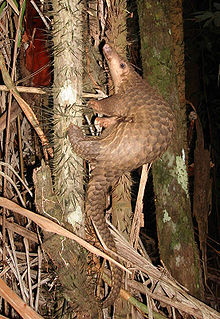
Anteater
Anteaters, also known as antbear, are the four mammal species of the suborder Vermilingua commonly known for eating ants and termites. Together with the sloths, they compose the order Pilosa...
species.
- Family: Manidae
- Genus: Manis
- Sunda Pangolin Manis javanica LR/nt
- Chinese PangolinChinese PangolinThe Chinese Pangolin is a pangolin that is found in north India, Nepal, Bhutan, possibly Bangladesh, across Myanmar to northern Indochina, through most of Taiwan and southern China, including the islands of Hainan.-Conservation:...
Manis pentadactyla LR/nt
- Genus: Manis
Order: CetaceaCetaceaThe order Cetacea includes the marine mammals commonly known as whales, dolphins, and porpoises. Cetus is Latin and is used in biological names to mean "whale"; its original meaning, "large sea animal", was more general. It comes from Ancient Greek , meaning "whale" or "any huge fish or sea...
(whales)
----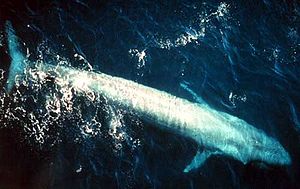


Whale
Whale is the common name for various marine mammals of the order Cetacea. The term whale sometimes refers to all cetaceans, but more often it excludes dolphins and porpoises, which belong to suborder Odontoceti . This suborder also includes the sperm whale, killer whale, pilot whale, and beluga...
s, dolphin
Dolphin
Dolphins are marine mammals that are closely related to whales and porpoises. There are almost forty species of dolphin in 17 genera. They vary in size from and , up to and . They are found worldwide, mostly in the shallower seas of the continental shelves, and are carnivores, mostly eating...
s and porpoise
Porpoise
Porpoises are small cetaceans of the family Phocoenidae; they are related to whales and dolphins. They are distinct from dolphins, although the word "porpoise" has been used to refer to any small dolphin, especially by sailors and fishermen...
s. They are the mammals most fully adapted to aquatic
Aquatic adaptation
Several animal groups have undergone aquatic adaptation, going from being purely terrestrial animals to living at least part of the time in water. The adaptations in early speciation tend to develop as the animal ventures into water in order to find available food. As successive generations spend...
life with a spindle-shaped nearly hairless body, protected by a thick layer of blubber, and forelimbs and tail modified to provide propulsion underwater.
- Suborder: Mysticeti
- Family: Balaenopteridae
- Subfamily: Balaenopterinae
- Genus: BalaenopteraBalaenopteraBalaenoptera is a genus of Balaenopteridae, the Rorqual whales, and contains eight species. The species Balaenoptera omurai was published in 2003...
- Blue WhaleBlue WhaleThe blue whale is a marine mammal belonging to the suborder of baleen whales . At in length and or more in weight, it is the largest known animal to have ever existed....
Balaenoptera musculus EN - Fin WhaleFin WhaleThe fin whale , also called the finback whale, razorback, or common rorqual, is a marine mammal belonging to the suborder of baleen whales. It is the second longest whale and the sixth largest living animal after the blue whale, bowhead whale, and right whales, growing to nearly 27 metres long...
Balaenoptera physalus EN
- Blue Whale
- Genus: Balaenoptera
- Subfamily: Megapterinae
- Genus: Megaptera
- Humpback WhaleHumpback WhaleThe humpback whale is a species of baleen whale. One of the larger rorqual species, adults range in length from and weigh approximately . The humpback has a distinctive body shape, with unusually long pectoral fins and a knobbly head. It is an acrobatic animal, often breaching and slapping the...
Megaptera novaeangliae VU
- Humpback Whale
- Genus: Megaptera
- Subfamily: Balaenopterinae
- Family: Balaenopteridae
- Suborder: Odontoceti
- Superfamily: Platanistoidea
- Family: Platanistidae
- Genus: Platanista
- Ganges River Dolphin Platanista gangetica EN
- Genus: Platanista
- Family: Phocoenidae
- Genus: Neophocaena
- Finless PorpoiseFinless PorpoiseThe finless porpoise is one of six porpoise species. In the waters around Japan, at the northern end of its range, it is known as the sunameri . A freshwater population found in the Yangtze River in China is known locally as the jiangzhu or "river pig". There is a degree of taxonomic uncertainty...
Neophocaena phocaenoides DD
- Finless Porpoise
- Genus: Neophocaena
- Family: Delphinidae (marine dolphins)
- Genus: Steno
- Rough-toothed DolphinRough-toothed DolphinThe Rough-toothed dolphin is species of dolphin that can be found in deep warm and tropical waters around the world.The species was first described by Georges Cuvier in 1823...
Steno bredanensis DD
- Rough-toothed Dolphin
- Genus: Tursiops
- Bottlenose DolphinBottlenose DolphinBottlenose dolphins, the genus Tursiops, are the most common and well-known members of the family Delphinidae, the family of oceanic dolphins. Recent molecular studies show the genus contains two species, the common bottlenose dolphin and the Indo-Pacific bottlenose dolphin , instead of one...
Tursiops aduncus DD - Bottlenose DolphinBottlenose DolphinBottlenose dolphins, the genus Tursiops, are the most common and well-known members of the family Delphinidae, the family of oceanic dolphins. Recent molecular studies show the genus contains two species, the common bottlenose dolphin and the Indo-Pacific bottlenose dolphin , instead of one...
Tursiops truncatus DD
- Bottlenose Dolphin
- Genus: StenellaStenellaStenella is a genus of aquatic mammals in Delphinidae, the family informally known as the oceanic dolphins.Currently five species are recognised in this genus:*Pantropical Spotted Dolphin, S. attenuata*Atlantic Spotted Dolphin, S. frontalis...
- Pantropical Spotted DolphinPantropical Spotted DolphinThe Pantropical Spotted Dolphin is a species of dolphin found in all the world's temperate and tropical oceans. The species was beginning to come under threat due to the killing of millions of individuals in tuna purse seines...
Stenella attenuata LR/cd - Spinner DolphinSpinner DolphinThe Spinner Dolphin is a small dolphin found in off-shore tropical waters around the world. It is famous for its acrobatic displays in which they spin longitudinally along their axis as they leap through the air.-Taxonomy:...
Stenella longirostris LR/cd
- Pantropical Spotted Dolphin
- Genus: Lagenodelphis
- Fraser's DolphinFraser's DolphinFraser's Dolphin or Sarawak Dolphin is a cetacean in the family Delphinidae found in deep waters in the Pacific Ocean and to a lesser extent in the Indian and Atlantic Oceans.-Taxonomy:...
Lagenodelphis hosei DD
- Fraser's Dolphin
- Genus: Grampus
- Risso's DolphinRisso's DolphinRisso's dolphin is the only species of dolphin in the genus Grampus.-Taxonomy:Risso's dolphin is named after Antoine Risso, whose description formed the basis of the first public description of the animal, by Georges Cuvier, in 1812...
Grampus griseus DD
- Risso's Dolphin
- Genus: Peponocephala
- Melon-headed WhaleMelon-headed WhaleThe melon-headed whale is a cetacean of the oceanic dolphin family . It is closely related to the pygmy killer whale and pilot whale, and collectively these dolphin species are known by the common name blackfish. It is also related to the false killer whale...
Peponocephala electra LR/lc
- Melon-headed Whale
- Genus: Feresa
- Pygmy Killer WhalePygmy Killer WhaleThe pygmy killer whale is a small, rarely seen cetacean of the oceanic dolphin family . It derives its common name from sharing some physical characteristics with the orca It is the smallest species that has "whale" in its common name. In fact, "killer" may be more apt in the case of the pygmy...
Feresa attenuata DD
- Pygmy Killer Whale
- Genus: Globicephala
- Pilot whalePilot whalePilot whales are cetaceans belonging to the genus Globicephala. There are two extant species, the long-finned pilot whale and the short-finned pilot whale . The two are not readily distinguished at sea and analysis of the skulls is the best way to tell the difference between them...
Globicephala macrorhynchus LR/cd
- Pilot whale
- Genus: OrcaellaOrcaellaThe snubfin dolphins are a genus of dolphins containing two members: the Irrawaddy Dolphin and Australian Snubfin Dolphin. The genus was long believed to be monotypic with the only species being the Irrawaddy Dolphin; however, in 2005, genetic analysis showed that the Australian Snubfin Dolphin is...
- Irrawaddy DolphinIrrawaddy dolphinThe Irrawaddy dolphin is a euryhaline species of oceanic dolphin found in discontinuous subpopulations near sea coasts and in estuaries and rivers in parts of the Bay of Bengal and Southeast Asia.-Etymology and taxonomic history:...
Orcaella brevirostris DD
- Irrawaddy Dolphin
- Genus: Steno
- Family: Platanistidae
- Superfamily: Platanistoidea
Order: CarnivoraCarnivoraThe diverse order Carnivora |Latin]] carō "flesh", + vorāre "to devour") includes over 260 species of placental mammals. Its members are formally referred to as carnivorans, while the word "carnivore" can refer to any meat-eating animal...
(carnivorans)
----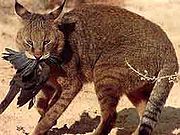
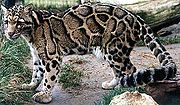


- Suborder: FeliformiaFeliformiaThe Feliformia are a suborder within the order Carnivora and includes cats , hyenas, mongooses, civets and related taxa. The other suborder of Carnivora is Caniformia...
- Family: FelidaeFelidaeFelidae is the biological family of the cats; a member of this family is called a felid. Felids are the strictest carnivores of the thirteen terrestrial families in the order Carnivora, although the three families of marine mammals comprising the superfamily pinnipedia are as carnivorous as the...
(cats)- Subfamily: FelinaeFelinaeFelinae is a subfamily of the family Felidae which includes the genera and species listed below. Most are small to medium-sized cats, although the group does include some larger animals, such as the Cougar and Cheetah....
- Genus: CatopumaCatopumaCatopuma is a genus including two small Asian felines, the Bay Cat and the Asian Golden Cat .Both are typically reddish brown in colour, with darker markings on the head. They inhabit forested environments in South East Asia, with the Bay Cat being restricted to the island of Borneo...
- Asian Golden Cat Catopuma temminckii VU
- Genus: FelisFelisFelis is a genus of cats in the family Felidae, including the familiar domestic cat and its closest wild relatives. The wild species are distributed widely across Europe, southern and central Asia, and Africa; the domestic cat has been introduced worldwide.Members of the genus Felis are all small...
- Jungle CatJungle CatThe jungle cat is a medium-sized cat and considered the largest remaining species of the wild cat genus Felis. The species is also called the swamp lynx but is not closely related to the lynxes....
Felis chaus LC
- Jungle Cat
- Genus: PardofelisPardofelisPardofelis was first proposed by the Russian explorer and naturalist Nikolai Severtzov in 1858 as generic name comprising a single felid species occurring in tropical Asia, the marbled cat Pardofelis marmorata....
- Marbled CatMarbled CatThe Marbled Cat is a small wild cat of South and Southeast Asia. Since 2002 it has been listed as vulnerable by IUCN as it occurs at low densities, and its total effective population size is suspected to be fewer than 10,000 mature individuals, with no single population numbering more than...
Pardofelis marmorata VU
- Marbled Cat
- Genus: PrionailurusPrionailurusPrionailurus is a genus of four species of small, spotted wild cats found in Asia. They are typically forest-dwelling. Most are able to swim well; some species are actually semi-aquatic and feed mainly on fish and other aquatic animals....
- Fishing CatFishing CatThe Fishing Cat is a medium-sized wild cat of South and Southeast Asia. In 2008, the IUCN classified the fishing cat as endangered since they are concentrated primarily in wetland habitats, which are increasingly being settled, degraded and converted...
Prionailurus viverrinus VU
- Fishing Cat
- Genus: Catopuma
- Subfamily: PantherinaePantherinaePantherinae is the subfamily of the family Felidae, which includes the genera Panthera, Uncia and Neofelis.The divergence of Pantherinae from Felinae has been ranked between six and ten million years ago. DNA analysis suggests that the snow leopard Uncia uncia is basal to the entire Pantherinae and...
- Genus: NeofelisNeofelisThe genus Neofelis comprises two species, the Clouded Leopard and the Sunda Clouded Leopard , which are classified as vulnerable by IUCN. Both species are listed on CITES Appendix I.- Characteristics :...
- Clouded LeopardClouded LeopardThe clouded leopard is a felid found from the Himalayan foothills through mainland Southeast Asia into China, and has been classified as vulnerable in 2008 by IUCN...
Neofelis nebulosa VU
- Clouded Leopard
- Genus: PantheraPantheraPanthera is a genus of the family Felidae , which contains four well-known living species: the tiger, the lion, the jaguar, and the leopard. The genus comprises about half of the Pantherinae subfamily, the big cats...
- LeopardLeopardThe leopard , Panthera pardus, is a member of the Felidae family and the smallest of the four "big cats" in the genus Panthera, the other three being the tiger, lion, and jaguar. The leopard was once distributed across eastern and southern Asia and Africa, from Siberia to South Africa, but its...
Panthera pardus LC - TigerTigerThe tiger is the largest cat species, reaching a total body length of up to and weighing up to . Their most recognizable feature is a pattern of dark vertical stripes on reddish-orange fur with lighter underparts...
Panthera tigris EN
- Leopard
- Genus: Neofelis
- Subfamily: Felinae
- Family: Viverridae (civets, mongooses, etc.)
- Subfamily: ParadoxurinaeParadoxurinaeParadoxurinae is a subfamily of viverrids....
- Genus: Arctictis
- BinturongBinturongThe Binturong , also known as the Asian Bearcat, the Palawan Bearcat, or simply the Bearcat, is a species of the family Viverridae, which includes the civets and genets. It is the only member of its genus...
Arctictis binturong LR/lc
- Binturong
- Genus: Arctogalidia
- Small-toothed Palm CivetSmall-toothed Palm CivetThe Small-toothed Palm Civet , also known as the Three-striped Palm Civet, is a civet. It lives in dense forests of southeast Asia, from the Assam district of India to Indochina and the Malay Peninsula and on Sumatra, Bangka, Java, Borneo, and numerous small nearby islands of Indonesia.The...
Arctogalidia trivirgata LR/lc
- Small-toothed Palm Civet
- Genus: Paguma
- Genus: ParadoxurusParadoxurusParadoxurus is a genus of viverrids in one of the civet subfamilies, Paradoxurinae. There are at least six species, one of which is common over tropical Asia, while the others are less common and limited in locality:...
- Asian Palm Civet Paradoxurus hermaphroditus LR/lc
- Genus: Arctictis
- Subfamily: ViverrinaeViverrinaeThe subfamily Viverrinae is the largest of the four subfamilies within the family Viverridae, containing the genets, some of the Asian civets, and the two African linsangs for a total of 22 species, comprising two-thirds of the Viverrids....
- Genus: ViverraViverraViverra is a genus of civet commonly found in Southeast Asia.-Species:* Malabar Large-spotted Civet * Large-spotted Civet * Malayan Civet * Large Indian Civet...
- Large Indian CivetLarge Indian CivetThe Large Indian Civet is a member of the Viverrid family native to Southeast Asia. In 2008, the IUCN classified the species as Near Threatened, mainly because of the known heavy trade as wild meat.- Characteristics :...
Viverra zibetha LR/lc
- Large Indian Civet
- Genus: Viverricula
- Small Indian CivetSmall Indian CivetThe Small Indian Civet or Rasse is a species of civet found across south and South-east Asia as well as in the Indonesian archipelago. The Assamese name Johamaal refers to its glandular odour similar to a scented rice variety called Joha...
Viverricula indica LR/lc
- Small Indian Civet
- Genus: Viverra
- Subfamily: Paradoxurinae
- Family: Herpestidae (mongooses)
- Genus: HerpestesHerpestesHerpestes is a genus of the mongoose family, Herpestidae .It contains the following species and subspecies:* Short-tailed Mongoose, Herpestes brachyurus** H. b. brachyurus...
- Small Asian Mongoose Herpestes javanicus LR/lc
- Genus: Herpestes
- Family: Felidae
- Suborder: CaniformiaCaniformiaCaniformia, or Canoidea , is a suborder within the order Carnivora. They typically possess a long snout and non-retractile claws . The Pinnipedia evolved from caniform ancestors and are accordingly assigned to this group...
- Family: CanidaeCanidaeCanidae is the biological family of carnivorous and omnivorous mammals that includes wolves, foxes, jackals, coyotes, and domestic dogs. A member of this family is called a canid . The Canidae family is divided into two tribes: Canini and Vulpini...
(dogs, foxes)- Genus: VulpesVulpesVulpes is a genus of the Canidae family. Its members are referred to as 'true foxes', although there are species in other genera whose common names include the word 'fox'....
- Bengal FoxBengal FoxThe Bengal fox , also known as the Indian fox, is a fox endemic to the Indian subcontinent and is found from the Himalayan foothills and Terai of Nepal through southern India and from southern and eastern Pakistan to eastern India and southeastern Bangladesh.-Appearance:Vulpes bengalensis is a...
Vulpes bengalensis LC - Red FoxRed FoxThe red fox is the largest of the true foxes, as well as being the most geographically spread member of the Carnivora, being distributed across the entire northern hemisphere from the Arctic Circle to North Africa, Central America, and the steppes of Asia...
Vulpes vulpes LC
- Bengal Fox
- Genus: Cuon
- DholeDholeThe dhole is a species of canid native to South and Southeast Asia. It is the only extant member of the genus Cuon, which differs from Canis by the reduced number of molars and greater number of teats...
Cuon alpinus EN
- Dhole
- Genus: Vulpes
- Family: Ursidae (bears)
- Genus: Ursus
- Asiatic Black BearAsiatic Black BearThe Asian black bear , also known as the moon bear or white-chested bear is a medium-sized species of bear, largely adapted for arboreal life, which occurs through much of southern Asia, Korea, northeastern China, the Russian far east and Honshū and Shikoku islands of Japan...
Ursus thibetanus VU
- Asiatic Black Bear
- Genus: Helarctos
- Sun BearSun BearThe sun bear , sometimes known as the honey bear, is a bear found primarily in the tropical rainforests of Southeast Asia; North-East India, Bangladesh, Myanmar, Thailand, Laos, Cambodia, Vietnam, Southern China, Peninsular Malaysia, and the islands of Sumatra and Borneo.-Description:The sun bear...
Helarctos malayanus DD
- Sun Bear
- Genus: LutrogaleLutrogaleLutrogale is a genus of otter, with only one extant species - the smooth-coated otter.*† Lutrogale cretensis - Cretan Otter*† Lutrogale palaeoleptonyx*Lutrogale perspicillata - Smooth-coated Otter...
- Smooth-coated OtterSmooth-coated OtterThe Smooth-coated Otter is a species of otter, the only extant representative of the genus Lutrogale. The species is found from southern Pakistan and parts of the India east to Southeast Asia, and there is a disjunct population in Iraq...
Lutrogale perspicillata VU
- Smooth-coated Otter
- Genus: AonyxAonyxAonyx is a genus of otters, containing two species, the African Clawless Otter and the Oriental Small-clawed Otter. The word 'Aonyx' means 'clawless', derived from the prefix 'a-' and .-Species and subspecies:...
- Oriental Small-clawed OtterOriental Small-clawed OtterThe oriental small-clawed otter , also known as Asian small-clawed otter, is the smallest otter species in the world, weighing less than 5 kg. It lives in mangrove swamps and freshwater wetlands of Bangladesh, Burma, India, southern China, Taiwan, Laos, Malaysia, Indonesia, the Philippines,...
Aonyx cinereus NT
- Oriental Small-clawed Otter
- Genus: Ursus
- Family: Canidae
Order: Perissodactyla (odd-toed ungulates)
----
Grazing
Grazing generally describes a type of feeding, in which a herbivore feeds on plants , and also on other multicellular autotrophs...
mammals. They are usually large to very large, and have relatively simple stomachs and a large middle toe.
- Family: Rhinocerotidae
- Genus: RhinocerosRhinocerosRhinoceros , also known as rhino, is a group of five extant species of odd-toed ungulates in the family Rhinocerotidae. Two of these species are native to Africa and three to southern Asia....
- Javan RhinocerosJavan RhinocerosThe Javan Rhinoceros or Lesser One-horned Rhinoceros is a member of the family Rhinocerotidae and one of five extant rhinoceroses...
Rhinoceros sondaicus CR - Indian RhinocerosIndian RhinocerosThe Indian Rhinoceros is also called Greater One-horned Rhinoceros and Asian One-horned Rhinoceros and belongs to the Rhinocerotidae family...
Rhinoceros unicornis EN
- Javan Rhinoceros
- Genus: Dicerorhinus
- Sumatran RhinocerosSumatran RhinocerosThe Sumatran Rhinoceros is a member of the family Rhinocerotidae and one of five extant rhinoceroses. It is the only extant species of the genus Dicerorhinus. It is the smallest rhinoceros, although is still a large mammal. This rhino stands high at the shoulder, with a head-and-body length of ...
Dicerorhinus sumatrensis CR
- Sumatran Rhinoceros
- Genus: Rhinoceros
Order: Artiodactyla (even-toed ungulates)
----

Ungulate
Ungulates are several groups of mammals, most of which use the tips of their toes, usually hoofed, to sustain their whole body weight while moving. They make up several orders of mammals, of which six to eight survive...
s whose weight is borne about equally by the third and fourth toes, rather than mostly or entirely by the third as in perissodactyls. There are about 220 artiodactyl species, including many that are of great economic importance to human
Human
Humans are the only living species in the Homo genus...
s.
- Family: SuidaeSuidaeSuidae is the biological family to which pigs belong. In addition to numerous fossil species, up to sixteen extant species are currently recognized, classified into between four and eight genera...
(pigs)- Subfamily: SuinaeSuinaeSuinae is a subfamily of mammals that includes at least some of the living members of the family Suidae and their closest relatives—the domestic pig and related species, such as babirusas. Several extinct species within Suidae are classified in subfamilies other than Suinae...
- Genus: Sus
- Pygmy HogPygmy HogPygmy hog is an endangered species of small wild pig, previously spread across India, Nepal, and Bhutan but now only found in Assam. The current world population is about 150 individuals or fewer...
Sus salvanius CR - BoarBoarWild boar, also wild pig, is a species of the pig genus Sus, part of the biological family Suidae. The species includes many subspecies. It is the wild ancestor of the domestic pig, an animal with which it freely hybridises...
Sus scrofa LR/lc
- Pygmy Hog
- Genus: Sus
- Subfamily: Suinae
- Family: Cervidae (deer)
- Subfamily: CervinaeCervinaeCervinae or the Old World deer , is a subfamily of deer. Alternatively, they're known as the Plesiometacarpal deer, due to their ankle structure being different from the Telemetecarpal deer of Capreolinae-Classification and Species:The list is based on the studies of Randi, Mucci, Claro-Hergueta,...
- Genus: CervusCervusCervus is a genus of deer that primarily are native to Eurasia, although one species occurs in northern Africa and another in North America. In addition to the species presently placed in this genus, it has included a whole range of other species now commonly placed in other genera, but some of...
- BarasinghaBarasinghaThe Barasingha or Swamp deer is a deer species currently found in isolated localities in north and central India, and southwestern Nepal, and is extinct in Pakistan and Bangladesh....
Cervus duvaucelii VU
- Barasingha
- Genus: Axis
- ChitalChitalThe chital or cheetal , also known as chital deer, spotted deer or axis deer is a deer which commonly inhabits wooded regions of Sri Lanka, Nepal, Bangladesh, Bhutan, India, and in small numbers in Pakistan...
Axis axis LR/lc
- Chital
- Genus: Cervus
- Subfamily: Muntiacinae
- Genus: Muntiacus
- Indian MuntjacIndian MuntjacThe Common Muntjac , also called the Red Muntjac, Indian Muntjac or Barking deer is the most numerous muntjac deer species. It has soft, short, brownish or greyish hair, sometimes with creamy markings. This species is omnivorous, feeding on fruits, shoots, seeds, birds' eggs as well as small...
Muntiacus muntjak LR/lc
- Indian Muntjac
- Genus: Muntiacus
- Subfamily: Cervinae
- Family: Bovidae (cattle, antelope, sheep, goats)
- Subfamily: AntilopinaeAntilopinaeAntilopinae is a subfamily of Bovidae. The gazelles, blackbucks, springboks, gerenuks, dibatags and Central Asian gazelles are often referred to as "True Antelopes" and are usually the sole representatives of the Antilopinae...
- Genus: AntilopeAntilopeAntilope is a genus of antelope in the subfamily Antilopinae that contains a single living species, the blackbuck and fossil species such as Antilope subtorta, Antilope planicornis, and Antilope intermedius....
- BlackbuckBlackbuckBlackbuck is a species of antelope native to the Indian subcontinent. Their range decreased sharply during the 20th century. Since 2003, the IUCN lists the species as near threatened....
Antilope cervicapra NT
- Blackbuck
- Genus: Antilope
- Subfamily: BovinaeBovinaeThe biological subfamily Bovinae includes a diverse group of 10 genera of medium to large sized ungulates, including domestic cattle, the bison, African buffalo, the water buffalo, the yak, and the four-horned and spiral-horned antelopes...
- Genus: BosBosBos is the genus of wild and domestic cattle. Bos can be divided into four subgenera: Bos, Bibos, Novibos, and Poephagus, but these divisions are controversial. The genus has five extant species...
- GaurGaurThe gaur , also called Indian bison, is a large bovine native to South Asia and Southeast Asia. The species is listed as vulnerable on the IUCN Red List since 1986 as the population decline in parts of the species' range is likely to be well over 70% over the last three generations...
Bos frontalis VU - BantengBantengThe banteng , also known as tembadau, is a species of wild cattle found in Southeast Asia.Banteng have been domesticated in several places in Southeast Asia, and there are around 1.5 million domestic banteng, which are called Bali cattle. These animals are used as working animals and for their meat...
Bos javanicus EN
- Gaur
- Genus: Boselaphus
- NilgaiNilgaiThe nilgai , sometimes called nilgau, is an antelope, and is one of the most commonly seen wild animals of central and northern India and eastern Pakistan; it is also present in parts of southern Nepal. The mature males appear ox-like and are also known as blue bulls...
Boselaphus tragocamelus LC
- Nilgai
- Genus: Bos
- Subfamily: Caprinae
- Genus: NemorhaedusNemorhaedusThe gorals are four species in the genus Nemorhaedus or Naemorhedus. They are small ungulates with a goat-like or antelope-like appearance....
- Mainland SerowMainland SerowThe Mainland Serow is a species of goat antelope native to China and Southeast Asia. The name "mainland serow" was formerly referring to Capricornis sumatraensis, which used to be the scientific name for all serows in the mainland and Sumatra when they were all considered to be the same species...
Nemorhaedus sumatraensis VU
- Mainland Serow
- Genus: Nemorhaedus
- Subfamily: Antilopinae
See also
- List of chordate orders
- List of regional mammals lists
- List of prehistoric mammals
- Mammal classificationMammal classificationMammalia is a class of animal within the Phylum Chordata. Mammal classification has been through several iterations since Carolus Linnaeus initially defined the class. Many earlier ideas have been completely abandoned by modern taxonomists, among these are the idea that bats are related to birds...
- New mammal species

